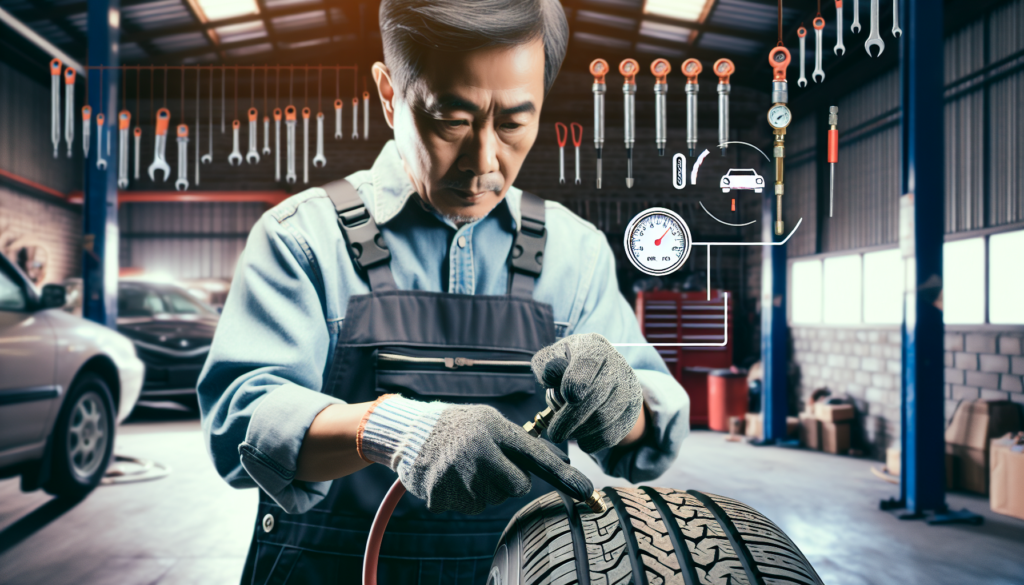Imagine you’re driving down the road and suddenly, you hear a loud pop. Your heart races as you pull over to the side, only to discover that one of your tires has gone flat. Luckily, you have a spare tire in the trunk, but have you ever wondered how to maintain the pressure in that spare tire? It’s a question that often goes overlooked, yet it’s crucial to ensure your safety and the longevity of your spare. In this article, we will explore some simple yet effective methods to keep your spare tire properly inflated, so you can stay on the road with peace of mind.

Checking Tire Pressure
Visual Inspection
To ensure your tires are properly inflated, it is important to conduct regular visual inspections. Take a close look at each tire to check for any signs of wear, punctures, or other damage. Additionally, inspect the valve stems for any signs of leakage. If you notice any issues during your visual inspection, it may be necessary to address them before proceeding with checking the tire pressure.
Using a Tire Pressure Gauge
One of the most accurate ways to check tire pressure is by using a tire pressure gauge. This small tool allows you to measure the air pressure inside each tire accurately. To use a tire pressure gauge, simply remove the valve cap from the tire, press the gauge onto the valve stem, and read the pressure measurement displayed on the gauge. It is recommended to check the tire pressure when the tires are cold, as driving can increase the temperature inside the tires and potentially affect the readings.
Inflating the Spare Tire
Using an Air Compressor
If your spare tire is low on pressure, you can easily inflate it using an air compressor. Start by removing the valve cap from the tire, then attach the air compressor hose to the valve stem. Set the compressor to the recommended pressure level specified by the manufacturer or your vehicle manual. Activate the compressor, and monitor the tire pressure using a tire pressure gauge as you fill it. Once the desired pressure is reached, carefully remove the compressor hose and replace the valve cap securely.
Using a Gas Station Air Pump
If you don’t have access to an air compressor, you can use a gas station air pump to inflate your spare tire. Simply park your vehicle close to the air pump, remove the valve cap, and attach the pump hose to the valve stem. Most gas station air pumps have a gauge that displays the current pressure, allowing you to monitor and adjust the inflation process. Remember to fill the tire to the recommended pressure and replace the valve cap when finished.
Using a Portable Inflator
A portable inflator is a handy tool to have in case of emergencies. It is compact, easy to use, and can be stored in your vehicle for quick access. To inflate your spare tire with a portable inflator, connect the hose to the valve stem and set the desired pressure level. Activate the inflator and monitor the pressure gauge as you fill the tire. Once the tire reaches the recommended pressure, disconnect the inflator, and secure the valve cap.
Tire Pressure Guidelines
Manufacturer Recommendation
The first source of information for determining the recommended tire pressure is the manufacturer’s guidelines. These guidelines can usually be found on a sticker inside the driver’s door jamb, glove compartment, or in the vehicle’s manual. The manufacturer takes into account various factors such as tire size, load capacity, and vehicle weight to determine the optimal tire pressure.
Checking the Vehicle Manual
If you are unsure of the manufacturer’s recommended tire pressure, you can also refer to your vehicle’s manual. The manual provides specific details about tire pressure based on the make, model, and year of your vehicle. It is important to follow the guidelines provided in the manual to ensure optimal tire performance and safety.
Determining Optimal Pressure
In some cases, you may need to determine the optimal tire pressure based on specific needs. For example, if you regularly carry heavy loads or frequently drive on rough terrain, you may need to inflate your tires to a slightly higher pressure to accommodate the extra weight. However, it is essential to consult with a tire professional or refer to the manufacturer’s recommendations before deviating from the standard pressure guidelines.
Considering Load Capacity
Another factor to consider when determining tire pressure is the load capacity of your vehicle. A heavily loaded vehicle may require higher tire pressure to ensure proper handling and stability. Conversely, if your vehicle is only carrying a light load or is lightly loaded, you may need to adjust the tire pressure accordingly. Consult the load capacity specifications provided by the manufacturer or your vehicle manual to determine the appropriate tire pressure for your specific situation.
Importance of Proper Tire Pressure
Improved Safety
Maintaining the correct tire pressure is crucial for ensuring your safety on the road. Underinflated or overinflated tires can lead to decreased traction, reduced handling capabilities, and longer braking distances. By keeping your tires properly inflated, you enhance the overall safety of your vehicle and reduce the risk of accidents caused by tire-related issues.
Enhanced Fuel Efficiency
Proper tire pressure also has a direct impact on your vehicle’s fuel efficiency. Underinflated tires can lead to increased rolling resistance, which requires more fuel to maintain the same speed. By regularly checking and maintaining the correct tire pressure, you can optimize your fuel efficiency, resulting in savings at the pump and reduced carbon emissions.
Reduced Tire Wear
Inadequate tire pressure can cause uneven tire wear, leading to premature tire replacement. Overinflated tires tend to wear more quickly in the center, while underinflated tires wear on the edges. By keeping your tires properly inflated, you can ensure even tire wear and extend the lifespan of your tires, saving you money in the long run.
Better Handling and Performance
Maintaining the correct tire pressure is essential for optimal handling and performance of your vehicle. Properly inflated tires provide better traction, stability, and responsiveness, allowing you to control your vehicle with ease. Whether you are navigating through tight turns or driving in adverse weather conditions, maintaining proper tire pressure enhances your vehicle’s overall performance and handling capabilities.

Common Causes of Tire Pressure Loss
Temperature Fluctuations
Temperature fluctuations can cause changes in tire pressure. As the temperature drops, the air inside the tires contracts, leading to a decrease in pressure. Similarly, as the temperature rises, the air expands, resulting in an increase in pressure. It is important to check and adjust your tire pressure regularly, especially during extreme temperature changes, to ensure optimal performance.
Leaky Valve Stems
Valve stems can develop leaks over time, causing gradual loss of tire pressure. Inspect the valve stems during your visual inspections for any signs of leakage, such as hissing sounds or visible air escaping. If you suspect a leaky valve stem, it is recommended to have it replaced by a professional to prevent further tire pressure loss.
Slow Air Leak
Slow air leaks can occur due to punctures, small cracks, or damage to the tire itself. Over time, these leaks can cause a gradual loss of tire pressure. If you notice that your tire pressure keeps decreasing despite regular inflation, it is recommended to inspect the tire for any signs of damage and have it repaired or replaced if necessary.
Puncture or Damage
Tire punctures and damage can also cause sudden loss of tire pressure. Sharp objects on the road, such as nails or glass, can easily penetrate the tire and lead to a flat or significantly deflated tire. It is important to inspect your tires regularly for any visible damage and address any punctures promptly to prevent further problems.
Tips for Maintaining Tire Pressure
Regular Pressure Checks
Regularly checking your tire pressure is one of the best ways to maintain optimal tire performance. Make it a habit to check the tire pressure at least once a month and before long trips. By doing so, you can detect and address any irregularities promptly and ensure your tires are always properly inflated.
Avoid Overinflation
While underinflation is a common issue, overinflating your tires can also cause problems. Overinflated tires have less contact with the road, leading to a harsher ride, increased risk of tire damage, and decreased traction. Follow the manufacturer’s recommended tire pressure guidelines and avoid exceeding the maximum pressure indicated on the tire sidewall.
Keep Spare Tire Clean and Dry
The spare tire is often overlooked but plays a crucial role in emergencies. To maintain proper tire pressure in your spare tire, keep it clean and dry. Regularly inspect the spare tire for any signs of damage or punctures and address them promptly. Additionally, ensure that the valve stem is free of leaks and properly sealed.
Inspect Tire for Damage
Performing regular visual inspections of your tires allows you to identify any signs of damage or wear. Look for bulges, cracks, or cuts on the tire’s sidewall and tread surface. If you notice any damage, it is important to have a professional assess the tire and determine if it can be repaired or needs to be replaced.

Monitoring Tire Pressure
Using TPMS (Tire Pressure Monitoring System)
Many modern vehicles are equipped with a Tire Pressure Monitoring System (TPMS) that continuously monitors the tire pressure and alerts you if any tire becomes significantly underinflated. If your vehicle has a TPMS, pay attention to any warning lights or messages on the dashboard and take the necessary steps to address the low tire pressure promptly.
Manual Pressure Checks
Although TPMS provides convenience, it is still recommended to manually check the tire pressure to ensure accuracy. TPMS sensors may not always detect slight pressure deviations, and relying solely on the system may lead to overlooking potential issues. By using a tire pressure gauge, you can get an accurate reading of each tire’s pressure and confirm the TPMS readings.
Additional Indicators of Low Pressure
Aside from monitoring your tire pressure visually or through TPMS, there are other indicators of low tire pressure to look out for. These include decreased fuel efficiency, increased tire noise, uneven tire wear, and decreased handling and stability. If you notice any of these signs, it is important to check your tire pressure and address any issues promptly.
Handling a Flat Spare Tire
Inspecting the Tire for Damage
In the unfortunate event of a flat spare tire, inspect the tire carefully for any visible damage or punctures. If the tire is severely damaged or has a puncture that cannot be safely repaired, it may need to be replaced. Additionally, if the tire is excessively worn or has uneven wear, it is recommended to have it replaced to ensure optimal performance in an emergency situation.
Repairing or Replacing the Spare Tire
If the spare tire has a minor puncture or damage that can be safely repaired, you have the option to fix it. Consult a tire professional to evaluate the tire and determine if it can be repaired according to industry standards. If the tire is repairable, follow the recommended repair procedures or have it repaired by a professional. However, if the damage is extensive or cannot be repaired, it is crucial to replace the spare tire with a new one.

Emergency Tire Repair
Temporary Repair Kits
Temporary tire repair kits can be useful in emergency situations where a conventional spare tire is not available. These kits typically include a sealant that can temporarily seal small punctures and allow you to continue driving to a repair facility. However, it is important to note that these kits are not a permanent solution and should only be used as a temporary fix until you can properly address the tire damage.
Calling for Roadside Assistance
In some cases, it may be best to call for roadside assistance if you are unsure or unable to address a tire-related issue. Roadside assistance professionals have the expertise and equipment to handle various tire repair situations and can ensure the safety and proper repair of your tire. When in doubt or if you are facing a challenging tire issue, do not hesitate to call for professional assistance.
Best Practices for Spare Tire Maintenance
Regular Inspection and Maintenance
To ensure the reliability of your spare tire, conduct regular inspections and maintenance. Check the tire pressure monthly or before long trips, visually inspect for any damage or punctures, and make sure the valve stem is intact and leak-free. Additionally, ensure that the spare tire is securely mounted and easily accessible in case of emergencies.
Rotation and Replacement
Rotating your spare tire during regular tire rotations can help maintain its condition and prolong its lifespan. By including the spare tire in the rotation schedule, you distribute the wear evenly among all tires, ensuring that the spare tire remains in good shape and ready for use. Additionally, if your spare tire shows signs of wear or damage, it is important to have it replaced promptly to ensure optimal performance when needed.
Proper Storage
When not in use, it is essential to store your spare tire properly to maintain its integrity. Store the spare tire in a clean, cool, and dry environment to prevent degradation and damage. Avoid exposure to sunlight, extreme temperatures, and moisture, as these can accelerate wear and lead to premature tire failure. Regularly inspect the spare tire during storage to ensure it remains in good condition and address any issues promptly.
By following these tire pressure maintenance guidelines, you can ensure your tires are always properly inflated, enhancing safety, fuel efficiency, and overall performance. Regular visual inspections, utilizing tire pressure gauges, and understanding the manufacturer’s recommendations are key steps in maintaining optimal tire pressure. Additionally, staying proactive in monitoring tire pressure and promptly addressing any issues or damage will help extend the lifespan of your tires and provide peace of mind on the road. Remember to always prioritize safety when dealing with tire-related matters and consult a professional if you are unsure or need assistance.


